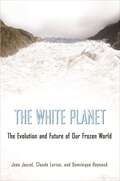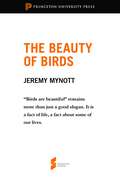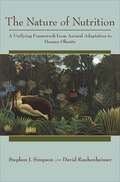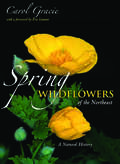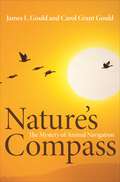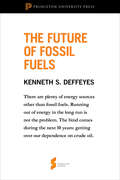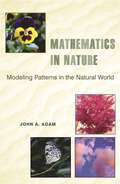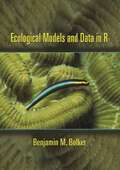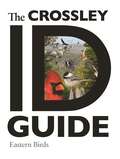- Table View
- List View
The White Planet: The Evolution and Future of Our Frozen World
by Jean Jouzel Claude Lorius Dominique Raynaud Teresa Lavender FaganFrom the Arctic Ocean and ice sheets of Greenland, to the glaciers of the Andes and Himalayas, to the great frozen desert of Antarctica, The White Planet takes readers on a spellbinding scientific journey through the shrinking world of ice and snow to tell the story of the expeditions and discoveries that have transformed our understanding of global climate. Written by three internationally renowned scientists at the center of many breakthroughs in ice core and climate science, this book provides an unparalleled firsthand account of how the "white planet" affects global climate--and how, in turn, global warming is changing the frozen world. Jean Jouzel, Claude Lorius, and Dominique Raynaud chronicle the daunting scientific, technical, and human hurdles that they and other scientists have had to overcome in order to unravel the mysteries of past and present climate change, as revealed by the cryosphere--the dynamic frozen regions of our planet. Scientifically impeccable, up-to-date, and accessible, The White Planet brings cutting-edge climate research to general readers through a vivid narrative. This is an essential book for anyone who wants to understand the inextricable link between climate and our planet's icy regions.
The Beauty of Birds: Birds in Our Imagination and Experience"
by Jeremy MynottSpring returns and with it the birds. But it also brings throngs of birders who emerge, binoculars in hand, to catch a glimpse of a rare or previously unseen species or to simply lay eyes on a particularly fine specimen of a familiar type. In a delightful meditation that unexpectedly ranges from the Volga Delta to Central Park and from Charles Dickens's Hard Times to a 1940s London burlesque show, Jeremy Mynott ponders what makes birds so beautiful and alluring to so many people. Princeton Shorts are brief selections taken from influential Princeton University Press books and produced exclusively in ebook format. Providing unmatched insight into important contemporary issues or timeless passages from classic works of the past, Princeton Shorts enable you to be an instant expert in a world where information is everywhere but quality is at a premium.
The Beauty of Birds: Birds in Our Imagination and Experience"
by Jeremy MynottSpring returns and with it the birds. But it also brings throngs of birders who emerge, binoculars in hand, to catch a glimpse of a rare or previously unseen species or to simply lay eyes on a particularly fine specimen of a familiar type. In a delightful meditation that unexpectedly ranges from the Volga Delta to Central Park and from Charles Dickens's Hard Times to a 1940s London burlesque show, Jeremy Mynott ponders what makes birds so beautiful and alluring to so many people. Princeton Shorts are brief selections taken from influential Princeton University Press books and produced exclusively in ebook format. Providing unmatched insight into important contemporary issues or timeless passages from classic works of the past, Princeton Shorts enable you to be an instant expert in a world where information is everywhere but quality is at a premium.
The Nature of Nutrition: A Unifying Framework from Animal Adaptation to Human Obesity
by Stephen J. Simpson David RaubenheimerNutrition has long been considered more the domain of medicine and agriculture than of the biological sciences, yet it touches and shapes all aspects of the natural world. The need for nutrients determines whether wild animals thrive, how populations evolve and decline, and how ecological communities are structured. The Nature of Nutrition is the first book to address nutrition's enormously complex role in biology, both at the level of individual organisms and in their broader ecological interactions. Stephen Simpson and David Raubenheimer provide a comprehensive theoretical approach to the analysis of nutrition--the Geometric Framework. They show how it can help us to understand the links between nutrition and the biology of individual animals, including the physiological mechanisms that determine the nutritional interactions of the animal with its environment, and the consequences of these interactions in terms of health, immune responses, and lifespan. Simpson and Raubenheimer explain how these effects translate into the collective behavior of groups and societies, and in turn influence food webs and the structure of ecosystems. Then they demonstrate how the Geometric Framework can be used to tackle issues in applied nutrition, such as the problem of optimizing diets for livestock and endangered species, and how it can also help to address the epidemic of human obesity and metabolic disease. Drawing on a wealth of examples from slime molds to humans, The Nature of Nutrition has important applications in ecology, evolution, and physiology, and offers promising solutions for human health, conservation, and agriculture.
The Nature of Nutrition: A Unifying Framework from Animal Adaptation to Human Obesity
by Stephen J. Simpson David RaubenheimerNutrition has long been considered more the domain of medicine and agriculture than of the biological sciences, yet it touches and shapes all aspects of the natural world. The need for nutrients determines whether wild animals thrive, how populations evolve and decline, and how ecological communities are structured. The Nature of Nutrition is the first book to address nutrition's enormously complex role in biology, both at the level of individual organisms and in their broader ecological interactions. Stephen Simpson and David Raubenheimer provide a comprehensive theoretical approach to the analysis of nutrition--the Geometric Framework. They show how it can help us to understand the links between nutrition and the biology of individual animals, including the physiological mechanisms that determine the nutritional interactions of the animal with its environment, and the consequences of these interactions in terms of health, immune responses, and lifespan. Simpson and Raubenheimer explain how these effects translate into the collective behavior of groups and societies, and in turn influence food webs and the structure of ecosystems. Then they demonstrate how the Geometric Framework can be used to tackle issues in applied nutrition, such as the problem of optimizing diets for livestock and endangered species, and how it can also help to address the epidemic of human obesity and metabolic disease. Drawing on a wealth of examples from slime molds to humans, The Nature of Nutrition has important applications in ecology, evolution, and physiology, and offers promising solutions for human health, conservation, and agriculture.
Physiological Adaptations for Breeding in Birds
by Tony D. WilliamsPhysiological Adaptations for Breeding in Birds is the most current and comprehensive account of research on avian reproduction. It develops two unique themes: the consideration of female avian reproductive physiology and ecology, and an emphasis on individual variation in life-history traits. Tony Williams investigates the physiological, metabolic, energetic, and hormonal mechanisms that underpin individual variation in the key female-specific reproductive traits and the trade-offs between these traits that determine variation in fitness. The core of the book deals with the avian reproductive cycle, from seasonal gonadal development, through egg laying and incubation, to chick rearing. Reproduction is considered in the context of the annual cycle and through an individual's entire life history. The book focuses on timing of breeding, clutch size, egg size and egg quality, and parental care. It also provides a primer on female reproductive physiology and considers trade-offs and carryover effects between reproduction and other life-history stages. In each chapter, Williams describes individual variation in the trait of interest and the evolutionary context for trait variation. He argues that there is only a rudimentary, and in some cases nonexistent, understanding of the physiological mechanisms that underpin individual variation in the major reproductive life-history traits, and that research efforts should refocus on these key unresolved problems by incorporating detailed physiological studies into existing long-term population studies, generating a new synthesis of physiology, ecology, and evolutionary biology.
Physiological Adaptations for Breeding in Birds
by Tony D. WilliamsPhysiological Adaptations for Breeding in Birds is the most current and comprehensive account of research on avian reproduction. It develops two unique themes: the consideration of female avian reproductive physiology and ecology, and an emphasis on individual variation in life-history traits. Tony Williams investigates the physiological, metabolic, energetic, and hormonal mechanisms that underpin individual variation in the key female-specific reproductive traits and the trade-offs between these traits that determine variation in fitness. The core of the book deals with the avian reproductive cycle, from seasonal gonadal development, through egg laying and incubation, to chick rearing. Reproduction is considered in the context of the annual cycle and through an individual's entire life history. The book focuses on timing of breeding, clutch size, egg size and egg quality, and parental care. It also provides a primer on female reproductive physiology and considers trade-offs and carryover effects between reproduction and other life-history stages. In each chapter, Williams describes individual variation in the trait of interest and the evolutionary context for trait variation. He argues that there is only a rudimentary, and in some cases nonexistent, understanding of the physiological mechanisms that underpin individual variation in the major reproductive life-history traits, and that research efforts should refocus on these key unresolved problems by incorporating detailed physiological studies into existing long-term population studies, generating a new synthesis of physiology, ecology, and evolutionary biology.
The Politics of Precaution: Regulating Health, Safety, and Environmental Risks in Europe and the United States
by David VogelThe Politics of Precaution examines the politics of consumer and environmental risk regulation in the United States and Europe over the last five decades, explaining why America and Europe have often regulated a wide range of similar risks differently. It finds that between 1960 and 1990, American health, safety, and environmental regulations were more stringent, risk averse, comprehensive, and innovative than those adopted in Europe. But since around 1990, the book shows, global regulatory leadership has shifted to Europe. What explains this striking reversal? David Vogel takes an in-depth, comparative look at European and American policies toward a range of consumer and environmental risks, including vehicle air pollution, ozone depletion, climate change, beef and milk hormones, genetically modified agriculture, antibiotics in animal feed, pesticides, cosmetic safety, and hazardous substances in electronic products. He traces how concerns over such risks--and pressure on political leaders to do something about them--have risen among the European public but declined among Americans. Vogel explores how policymakers in Europe have grown supportive of more stringent regulations while those in the United States have become sharply polarized along partisan lines. And as European policymakers have grown more willing to regulate risks on precautionary grounds, increasingly skeptical American policymakers have called for higher levels of scientific certainty before imposing additional regulatory controls on business.
The Politics of Precaution: Regulating Health, Safety, and Environmental Risks in Europe and the United States
by David VogelThe Politics of Precaution examines the politics of consumer and environmental risk regulation in the United States and Europe over the last five decades, explaining why America and Europe have often regulated a wide range of similar risks differently. It finds that between 1960 and 1990, American health, safety, and environmental regulations were more stringent, risk averse, comprehensive, and innovative than those adopted in Europe. But since around 1990, the book shows, global regulatory leadership has shifted to Europe. What explains this striking reversal? David Vogel takes an in-depth, comparative look at European and American policies toward a range of consumer and environmental risks, including vehicle air pollution, ozone depletion, climate change, beef and milk hormones, genetically modified agriculture, antibiotics in animal feed, pesticides, cosmetic safety, and hazardous substances in electronic products. He traces how concerns over such risks--and pressure on political leaders to do something about them--have risen among the European public but declined among Americans. Vogel explores how policymakers in Europe have grown supportive of more stringent regulations while those in the United States have become sharply polarized along partisan lines. And as European policymakers have grown more willing to regulate risks on precautionary grounds, increasingly skeptical American policymakers have called for higher levels of scientific certainty before imposing additional regulatory controls on business.
Spring Wildflowers of the Northeast: A Natural History
by Carol Gracie Eric LamontThis exquisitely illustrated volume provides an in-depth look at spring-blooming wildflowers of the Northeast, from old favorites to lesser-known species. Featuring more than 500 full-color photos in a stunning large-sized format, the book delves deep into the life histories, lore, and cultural uses of more than 35 plant species. The rich narrative covers topics such as the naming of wildflowers; the reasons for taxonomic changes; pollination of flowers and dispersal of seeds; uses by Native Americans; related species in other parts of the world; herbivores, plant pathogens, and pests; medicinal uses; and wildflower references in history, literature, and art. The photos capture the beauty of these plants and also illustrate the concepts discussed in the text. A book unlike any other, Spring Wildflowers of the Northeast combines the latest scientific research with an accessible, entertaining style, making it the ideal volume for readers of all levels of expertise. Showcases the Northeast's most spectacular spring-blooming wildflowers Features more than 500 full-color photos Covers the life histories, lore, and cultural uses of more than 35 species Combines the latest scientific research with an easy-to-read style Offers something new for seasoned botanists as well as armchair naturalists
Nature's Compass: The Mystery of Animal Navigation
by James L. Gould Carol Grant GouldWe know that animals cross miles of water, land, and sky with pinpoint precision on a daily basis. But it is only in recent years that scientists have learned how these astounding feats of navigation are actually accomplished. With colorful and thorough detail, Nature's Compass explores the remarkable methods by which animals find their way both near home and around the globe. Noted biologist James Gould and popular science writer Carol Gould delve into the elegant strategies and fail-safe backup systems, the invisible sensitivities and mysterious forces, and incredible mental abilities used by familiar and rare species, as they investigate a multitude of navigation strategies, from the simple to the astonishing. The Goulds discuss how animals navigate, without instruments and training, at a level far beyond human talents. They explain how animals measure time and show how the fragile monarch butterfly employs an internal clock, calendar, compass, and map to commence and measure the two-thousand-mile annual journey to Mexico--all with a brain that weighs only a few thousandths of an ounce. They look at honey bees and how they rely on the sun and mental maps to locate landmarks such as nests and flowers. And they examine whether long-distance migrants, such as the homing pigeon, depend on a global positioning system to let them know where they are. Ultimately, the authors ask if the disruption of migratory paths through habitat destruction and global warming is affecting and endangering animal species. Providing a comprehensive picture of animal navigation and migration, Nature's Compass decodes the mysteries of this extraordinary aspect of natural behavior.
Nature's Compass: The Mystery of Animal Navigation
by James L. Gould Carol Grant GouldWe know that animals cross miles of water, land, and sky with pinpoint precision on a daily basis. But it is only in recent years that scientists have learned how these astounding feats of navigation are actually accomplished. With colorful and thorough detail, Nature's Compass explores the remarkable methods by which animals find their way both near home and around the globe. Noted biologist James Gould and popular science writer Carol Gould delve into the elegant strategies and fail-safe backup systems, the invisible sensitivities and mysterious forces, and incredible mental abilities used by familiar and rare species, as they investigate a multitude of navigation strategies, from the simple to the astonishing. The Goulds discuss how animals navigate, without instruments and training, at a level far beyond human talents. They explain how animals measure time and show how the fragile monarch butterfly employs an internal clock, calendar, compass, and map to commence and measure the two-thousand-mile annual journey to Mexico--all with a brain that weighs only a few thousandths of an ounce. They look at honey bees and how they rely on the sun and mental maps to locate landmarks such as nests and flowers. And they examine whether long-distance migrants, such as the homing pigeon, depend on a global positioning system to let them know where they are. Ultimately, the authors ask if the disruption of migratory paths through habitat destruction and global warming is affecting and endangering animal species. Providing a comprehensive picture of animal navigation and migration, Nature's Compass decodes the mysteries of this extraordinary aspect of natural behavior.
The Future of Fossil Fuels: From "Hubbert’s Peak"
by Kenneth S. DeffeyesAs debates about the effects of fossil fuels on our climate and foreign policy intensify, the question of just how much longer we can depend on this finite source of energy becomes more and more pressing. This selection from Hubbert's Peak, the leading book on the limits of our oil supply, forecasts what the future will bring for fossil fuels and what the alternatives are likely to be. Princeton Shorts are brief selections excerpted from influential Princeton University Press publications produced exclusively in eBook format. They are selected with the firm belief that while the original work remains an important and enduring product, sometimes we can all benefit from a quick take on a topic worthy of a longer book. In a world where every second counts, how better to stay up-to speed on current events and digest the kernels of wisdom found in the great works of the past? Princeton Shorts enables you to be an instant expert in a world where information is everywhere but quality is at a premium. The Future of Fossil Fuels does just that.
The Future of Fossil Fuels: From "Hubbert’s Peak"
by Kenneth S. DeffeyesAs debates about the effects of fossil fuels on our climate and foreign policy intensify, the question of just how much longer we can depend on this finite source of energy becomes more and more pressing. This selection from Hubbert's Peak, the leading book on the limits of our oil supply, forecasts what the future will bring for fossil fuels and what the alternatives are likely to be. Princeton Shorts are brief selections excerpted from influential Princeton University Press publications produced exclusively in eBook format. They are selected with the firm belief that while the original work remains an important and enduring product, sometimes we can all benefit from a quick take on a topic worthy of a longer book. In a world where every second counts, how better to stay up-to speed on current events and digest the kernels of wisdom found in the great works of the past? Princeton Shorts enables you to be an instant expert in a world where information is everywhere but quality is at a premium. The Future of Fossil Fuels does just that.
Mathematics in Nature: Modeling Patterns in the Natural World
by John A. AdamFrom rainbows, river meanders, and shadows to spider webs, honeycombs, and the markings on animal coats, the visible world is full of patterns that can be described mathematically. Examining such readily observable phenomena, this book introduces readers to the beauty of nature as revealed by mathematics and the beauty of mathematics as revealed in nature. Generously illustrated, written in an informal style, and replete with examples from everyday life, Mathematics in Nature is an excellent and undaunting introduction to the ideas and methods of mathematical modeling. It illustrates how mathematics can be used to formulate and solve puzzles observed in nature and to interpret the solutions. In the process, it teaches such topics as the art of estimation and the effects of scale, particularly what happens as things get bigger. Readers will develop an understanding of the symbiosis that exists between basic scientific principles and their mathematical expressions as well as a deeper appreciation for such natural phenomena as cloud formations, halos and glories, tree heights and leaf patterns, butterfly and moth wings, and even puddles and mud cracks. Developed out of a university course, this book makes an ideal supplemental text for courses in applied mathematics and mathematical modeling. It will also appeal to mathematics educators and enthusiasts at all levels, and is designed so that it can be dipped into at leisure.
Mathematics in Nature: Modeling Patterns in the Natural World
by John A. AdamFrom rainbows, river meanders, and shadows to spider webs, honeycombs, and the markings on animal coats, the visible world is full of patterns that can be described mathematically. Examining such readily observable phenomena, this book introduces readers to the beauty of nature as revealed by mathematics and the beauty of mathematics as revealed in nature. Generously illustrated, written in an informal style, and replete with examples from everyday life, Mathematics in Nature is an excellent and undaunting introduction to the ideas and methods of mathematical modeling. It illustrates how mathematics can be used to formulate and solve puzzles observed in nature and to interpret the solutions. In the process, it teaches such topics as the art of estimation and the effects of scale, particularly what happens as things get bigger. Readers will develop an understanding of the symbiosis that exists between basic scientific principles and their mathematical expressions as well as a deeper appreciation for such natural phenomena as cloud formations, halos and glories, tree heights and leaf patterns, butterfly and moth wings, and even puddles and mud cracks. Developed out of a university course, this book makes an ideal supplemental text for courses in applied mathematics and mathematical modeling. It will also appeal to mathematics educators and enthusiasts at all levels, and is designed so that it can be dipped into at leisure.
Ecological Models and Data in R
by Benjamin M. BolkerEcological Models and Data in R is the first truly practical introduction to modern statistical methods for ecology. In step-by-step detail, the book teaches ecology graduate students and researchers everything they need to know in order to use maximum likelihood, information-theoretic, and Bayesian techniques to analyze their own data using the programming language R. Drawing on extensive experience teaching these techniques to graduate students in ecology, Benjamin Bolker shows how to choose among and construct statistical models for data, estimate their parameters and confidence limits, and interpret the results. The book also covers statistical frameworks, the philosophy of statistical modeling, and critical mathematical functions and probability distributions. It requires no programming background--only basic calculus and statistics. Practical, beginner-friendly introduction to modern statistical techniques for ecology using the programming language R Step-by-step instructions for fitting models to messy, real-world data Balanced view of different statistical approaches Wide coverage of techniques--from simple (distribution fitting) to complex (state-space modeling) Techniques for data manipulation and graphical display Companion Web site with data and R code for all examples
Ecological Models and Data in R
by Benjamin M. BolkerEcological Models and Data in R is the first truly practical introduction to modern statistical methods for ecology. In step-by-step detail, the book teaches ecology graduate students and researchers everything they need to know in order to use maximum likelihood, information-theoretic, and Bayesian techniques to analyze their own data using the programming language R. Drawing on extensive experience teaching these techniques to graduate students in ecology, Benjamin Bolker shows how to choose among and construct statistical models for data, estimate their parameters and confidence limits, and interpret the results. The book also covers statistical frameworks, the philosophy of statistical modeling, and critical mathematical functions and probability distributions. It requires no programming background--only basic calculus and statistics. Practical, beginner-friendly introduction to modern statistical techniques for ecology using the programming language R Step-by-step instructions for fitting models to messy, real-world data Balanced view of different statistical approaches Wide coverage of techniques--from simple (distribution fitting) to complex (state-space modeling) Techniques for data manipulation and graphical display Companion Web site with data and R code for all examples
Spatiotemporal Data Analysis
by Gidon EshelA severe thunderstorm morphs into a tornado that cuts a swath of destruction through Oklahoma. How do we study the storm's mutation into a deadly twister? Avian flu cases are reported in China. How do we characterize the spread of the flu, potentially preventing an epidemic? The way to answer important questions like these is to analyze the spatial and temporal characteristics--origin, rates, and frequencies--of these phenomena. This comprehensive text introduces advanced undergraduate students, graduate students, and researchers to the statistical and algebraic methods used to analyze spatiotemporal data in a range of fields, including climate science, geophysics, ecology, astrophysics, and medicine. Gidon Eshel begins with a concise yet detailed primer on linear algebra, providing readers with the mathematical foundations needed for data analysis. He then fully explains the theory and methods for analyzing spatiotemporal data, guiding readers from the basics to the most advanced applications. This self-contained, practical guide to the analysis of multidimensional data sets features a wealth of real-world examples as well as sample homework exercises and suggested exams.
Spatiotemporal Data Analysis
by Gidon EshelA severe thunderstorm morphs into a tornado that cuts a swath of destruction through Oklahoma. How do we study the storm's mutation into a deadly twister? Avian flu cases are reported in China. How do we characterize the spread of the flu, potentially preventing an epidemic? The way to answer important questions like these is to analyze the spatial and temporal characteristics--origin, rates, and frequencies--of these phenomena. This comprehensive text introduces advanced undergraduate students, graduate students, and researchers to the statistical and algebraic methods used to analyze spatiotemporal data in a range of fields, including climate science, geophysics, ecology, astrophysics, and medicine. Gidon Eshel begins with a concise yet detailed primer on linear algebra, providing readers with the mathematical foundations needed for data analysis. He then fully explains the theory and methods for analyzing spatiotemporal data, guiding readers from the basics to the most advanced applications. This self-contained, practical guide to the analysis of multidimensional data sets features a wealth of real-world examples as well as sample homework exercises and suggested exams.
Petrels, Albatrosses, and Storm-Petrels of North America: A Photographic Guide
by Steve N. HowellPetrels, albatrosses, and storm-petrels are among the most beautiful yet least known of all the world's birds, living their lives at sea far from the sight of most people. Largely colored in shades of gray, black, and white, these enigmatic and fast-flying seabirds can be hard to differentiate, particularly from a moving boat. Useful worldwide, not just in North America, this photographic guide is based on unrivaled field experience and combines insightful text and hundreds of full-color images to help you identify these remarkable birds. The first book of its kind, this guide features an introduction that explains ocean habitats and the latest developments in taxonomy. Detailed species accounts describe key identification features such as flight manner, plumage variation related to age and molt, seasonal occurrence patterns, and migration routes. Species accounts are arranged into groups helpful for field identification, and an overview of unique identification challenges is provided for each group. The guide also includes distribution maps for regularly occurring species as well as a bibliography, glossary, and appendixes. The first state-of-the-art photographic guide to these enigmatic seabirds Includes hundreds of full-color photos throughout Features detailed species accounts that describe flight, plumage, distribution, and more Provides overviews of ocean habitats, taxonomy, and conservation Offers tips on how to observe and identify birds at sea
Petrels, Albatrosses, and Storm-Petrels of North America: A Photographic Guide
by Steve N. HowellPetrels, albatrosses, and storm-petrels are among the most beautiful yet least known of all the world's birds, living their lives at sea far from the sight of most people. Largely colored in shades of gray, black, and white, these enigmatic and fast-flying seabirds can be hard to differentiate, particularly from a moving boat. Useful worldwide, not just in North America, this photographic guide is based on unrivaled field experience and combines insightful text and hundreds of full-color images to help you identify these remarkable birds. The first book of its kind, this guide features an introduction that explains ocean habitats and the latest developments in taxonomy. Detailed species accounts describe key identification features such as flight manner, plumage variation related to age and molt, seasonal occurrence patterns, and migration routes. Species accounts are arranged into groups helpful for field identification, and an overview of unique identification challenges is provided for each group. The guide also includes distribution maps for regularly occurring species as well as a bibliography, glossary, and appendixes. The first state-of-the-art photographic guide to these enigmatic seabirds Includes hundreds of full-color photos throughout Features detailed species accounts that describe flight, plumage, distribution, and more Provides overviews of ocean habitats, taxonomy, and conservation Offers tips on how to observe and identify birds at sea
The Crossley ID Guide: Eastern Birds
by Richard CrossleyThis stunningly illustrated book from acclaimed birder and photographer Richard Crossley revolutionizes field guide design by providing the first real-life approach to identification. Whether you are a beginner, expert, or anywhere in between, The Crossley ID Guide will vastly improve your ability to identify birds. Unlike other guides, which provide isolated individual photographs or illustrations, this is the first book to feature large, lifelike scenes for each species. These scenes--640 in all--are composed from more than 10,000 of the author's images showing birds in a wide range of views--near and far, from different angles, in various plumages and behaviors, including flight, and in the habitat in which they live. These beautiful compositions show how a bird's appearance changes with distance, and give equal emphasis to characteristics experts use to identify birds: size, structure and shape, behavior, probability, and color. This is the first book to convey all of these features visually--in a single image--and to reinforce them with accurate, concise text. Each scene provides a wealth of detailed visual information that invites and rewards careful study, but the most important identification features can be grasped instantly by anyone. By making identification easier, more accurate, and more fun than ever before, The Crossley ID Guide will completely redefine how its users look at birds. Essential for all birders, it also promises to make new birders of many people who have despaired of using traditional guides. Revolutionary. This book changes field guide design to make you a better birder A picture says a thousand words. The most comprehensive guide: 640 stunning scenes created from 10,000 of the author's photographs Reality birding. Lifelike in-focus scenes show birds in their habitats, from near and far, and in all plumages and behaviors Teaching and reference. The first book to accurately portray all the key identification characteristics: size, shape, behavior, probability, and color Practice makes perfect. An interactive learning experience to sharpen and test field identification skills Bird like the experts. The first book to simplify birding and help you understand how to bird like the best An interactive website--www.crossleybirds.com--includes expanded captions for the plates and species updates
The Crossley ID Guide: Eastern Birds
by Richard CrossleyThis stunningly illustrated book from acclaimed birder and photographer Richard Crossley revolutionizes field guide design by providing the first real-life approach to identification. Whether you are a beginner, expert, or anywhere in between, The Crossley ID Guide will vastly improve your ability to identify birds. Unlike other guides, which provide isolated individual photographs or illustrations, this is the first book to feature large, lifelike scenes for each species. These scenes--640 in all--are composed from more than 10,000 of the author's images showing birds in a wide range of views--near and far, from different angles, in various plumages and behaviors, including flight, and in the habitat in which they live. These beautiful compositions show how a bird's appearance changes with distance, and give equal emphasis to characteristics experts use to identify birds: size, structure and shape, behavior, probability, and color. This is the first book to convey all of these features visually--in a single image--and to reinforce them with accurate, concise text. Each scene provides a wealth of detailed visual information that invites and rewards careful study, but the most important identification features can be grasped instantly by anyone. By making identification easier, more accurate, and more fun than ever before, The Crossley ID Guide will completely redefine how its users look at birds. Essential for all birders, it also promises to make new birders of many people who have despaired of using traditional guides. Revolutionary. This book changes field guide design to make you a better birder A picture says a thousand words. The most comprehensive guide: 640 stunning scenes created from 10,000 of the author's photographs Reality birding. Lifelike in-focus scenes show birds in their habitats, from near and far, and in all plumages and behaviors Teaching and reference. The first book to accurately portray all the key identification characteristics: size, shape, behavior, probability, and color Practice makes perfect. An interactive learning experience to sharpen and test field identification skills Bird like the experts. The first book to simplify birding and help you understand how to bird like the best An interactive website--www.crossleybirds.com--includes expanded captions for the plates and species updates
Pollination and Floral Ecology
by Pat WillmerPollination and Floral Ecology is the most comprehensive single-volume reference to all aspects of pollination biology--and the first fully up-to-date resource of its kind to appear in decades. This beautifully illustrated book describes how flowers use colors, shapes, and scents to advertise themselves; how they offer pollen and nectar as rewards; and how they share complex interactions with beetles, birds, bats, bees, and other creatures. The ecology of these interactions is covered in depth, including the timing and patterning of flowering, competition among flowering plants to attract certain visitors and deter others, and the many ways plants and animals can cheat each other. Pollination and Floral Ecology pays special attention to the prevalence of specialization and generalization in animal-flower interactions, and examines how a lack of distinction between casual visitors and true pollinators can produce misleading conclusions about flower evolution and animal-flower mutualism. This one-of-a-kind reference also gives insights into the vital pollination services that animals provide to crops and native flora, and sets these issues in the context of today's global pollination crisis. Provides the most up-to-date resource on pollination and floral ecology Describes flower advertising features and rewards, foraging and learning by flower-visiting animals, behaviors of generalist and specialist pollinators--and more Examines the ecology and evolution of animal-flower interactions, from the molecular to macroevolutionary scale Features hundreds of color and black-and-white illustrations
